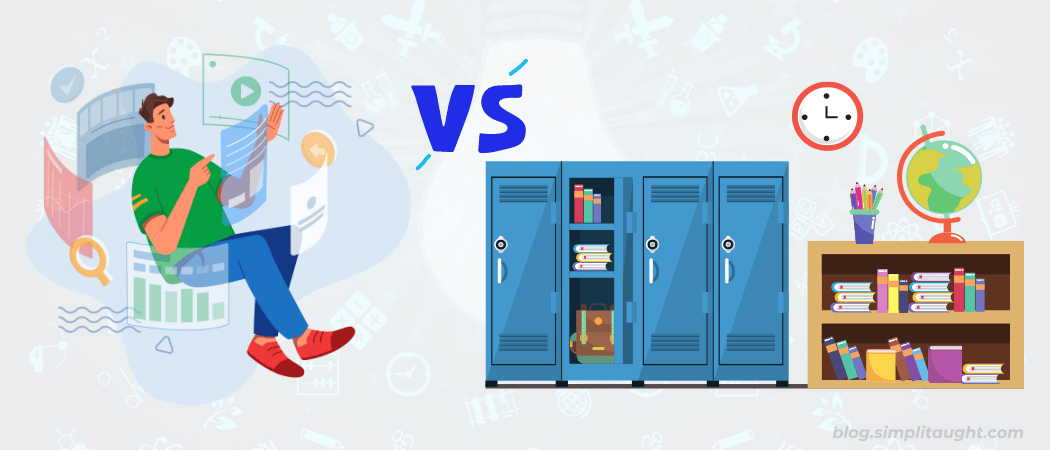Simply put, personalized learning is a more personal approach to learning. It is an approach that aims to customize learning according to individual needs, strengths, weaknesses, and interests.
In the race between personalized learning vs traditional learning, customized education is rapidly gaining momentum in the modern field of education. This growing popularity of personalized learning is rightly so, as it offers many more opportunities than traditional learning and teaching methods.
So, many educators and institutions are experimenting with different teaching and learning techniques to ensure learners receive the best education possible. In addition, they have been trying to customize learning because of the advantages of this approach. But the main question remains, how does personalized learning differ from traditional learning?
The Real Difference
Below we illustrate the critical differences between personalized learning vs traditional learning.
The Role of Educators
Educators play a crucial role in the traditional learning setup. The teachers take the central stage and guide all the students simultaneously. There is some interaction with the learners, but it is not enough because only extroverted and brilliant students receive the most attention. There is minimal interaction between educators and students.
In personalized learning, educators remain important but can even be delegated to the fringe if it’s an online program. Learners receive a personalized course with customized content to suit their learning style, aptitude, and preferences. Instructors are only there to offer support to students wherever needed.
The support students receive in personalized learning differs from traditional classroom setups, as the course materials are in digital forms, such as videos and digital content. The instructors are relieved of the burden, but it does not diminish their importance. However, it improves the student’s learning experience because now the educators do not have to explain the basic details and can concentrate on the specific issues of each learner.
Teaching Model
The teaching model differentiates personalized learning from traditional education. It focuses on each individual in a group. Learners can use the latest online software and digital technologies. Instructors pay attention to each learner. The main aim is to ensure that each student gets an equal opportunity to learn and succeed.
On the contrary, traditional learning takes the generic instructional approach. It usually uses the classroom teaching model, where the instructor explains the lesson content during class hours. So it happens in physical classrooms, where a group of learners and an educator are present during the educational process.
This technique delivers tried and tested outcomes. But, it does not consider different learners’ unique interests, shortcomings, and learning preferences. Hence, everyone in the classroom receives the same education in the same way. Therefore, educators or institutions do not customize the course or the instructional method.
The Learning Pace
In conventional education, all learners must learn simultaneously and at the same pace. The instructor takes a middle route and keeps a steady pace. Moreover, the teaching process does not speed up or slow down for different learners. This is where personalized learning differs from traditional education. Here, the students set the pace of learning instead of the teachers. Learners can learn at their own pace, depending on their comprehension of the learning material.
This learning technique even benefits students who grasp information quickly. Sometimes, students may not comprehend something, but they still have to move forward to keep up with the learning pace set by the instructor. However, with a personalized learning plan, a learner can take time to understand the material and only then move on to the next step. Hence, it ensures that every student has the same chance to succeed and learn a subject.
Interaction
While there is some form of interaction in the traditional learning approach, it is limited compared to the personalized learning strategies. Traditional learning depends heavily on written content and physical books. While most classrooms are now using multimedia systems, they remain secondary to the educator in conventional education. Therefore, the interaction between the instructors and learners is less than that in a personalized learning setup.
As personalized learning depends on digital content, it makes learning interactive. Therefore, students are not only limited to reading a lesson and answering questions. They are at the receiving end of interactive digital lessons. Educators and students must only input data, answers, and content into these modules. The software programs utilized for such purposes can evaluate some of these inputs automatically and instantly. Besides, learners can view their assessment reports quickly after completing lessons.
These personalized setups generate a lot of valuable data for both learners and teachers. Learners can easily see their learning and performance records. Educators can assess how each learner is progressing by checking their records. Hence, instructors can customize their following lessons based on students’ performances.
Periodic Vs. Ongoing Performance Evaluation
Learner performance is assessed periodically in traditional learning environments. Some exams and tests take place at set terms and intervals. This is how learners have always been analyzed for their performance, competency, skills, merit, and learning. In contrast, personalized learning does not rely on these fixed-term assessments. It evaluates performance regularly. In fact, educators can check them after every lesson as many reviews are done automatically with the aid of software tools, making the assessment process easy and quick.
This ongoing evaluation process helps customize the educational content to suit student learning requirements and pace. An instructor can pay more attention to students facing difficulty in understanding a lecture or a part of its content.
Final Thoughts!
Traditional learning environments avoid taking risks and choose the usual path. On the other hand, the outcomes are not always suitable for all learners. It simply becomes a process to impart knowledge at the least cost because educators and educational resources cannot be arranged separately for each learner.
Personalized learning using digital technologies has solved this problem to a great extent. In these environments, a learner receives custom content. It is an interactive learning system, and significant learning and evaluation data is available to the learners and instructors.






